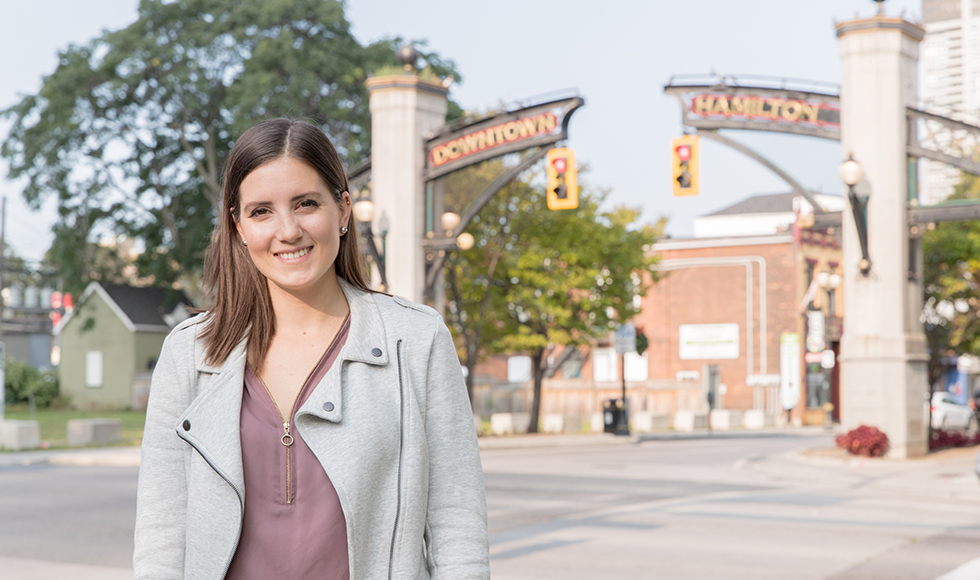Together and alone: Tackling senior isolation in Hamilton’s downtown

BY Matt Terry
November 8, 2017
On average, there are more than 500 people jammed into each square kilometre of the city of Hamilton. So why is it that so many of those people, particularly seniors, feel so alone?
That’s the question facing Rachel Weldrick, a PhD candidate in McMaster’s Health, Aging and Society program.
Weldrick was awarded a Vanier Canada Graduate Scholarship earlier this year to study urban social isolation, an under-studied phenomenon that’s been baffling scientists for years.
“What causes someone to feel cut-off from their community, despite being surrounded by people?” asks Weldrick. “We need to understand the experiences of our urban seniors.”
To do that, she’s sitting down with socially-isolated seniors (specifically women) living in downtown Hamilton and talking to them about their lives.
“Are they dealing with low income levels and can’t afford to get out and be social? Do they feel bullied by their neighbours? Do they feel like they live on an unsafe street? These are the sorts of things we need to find out,” says Weldrick.
Social isolation is an issue of rising concern in countries like Canada, whose population of seniors is now larger than its population of children: there are now 5.9 million Canadian seniors, compared to 5.8 million Canadians aged 14 years and under.
For the first time in #Canada, there are more #seniors than #children http://t.co/ydbaZUn7Gx pic.twitter.com/LSHxfRHIcY
— Statistics Canada (@StatCan_eng) September 29, 2015
By 2031, nearly a quarter of Canadians will be aged 65 or older.
Existing research on social isolation shows that it’s strongly linked to an increase in cognitive decline, dementia, depression and even premature death.
“A lot of older people aren’t creating strong relationships,” says Weldrick. “They’re lacking in social engagement and they don’t feel a sense of belonging.”
Weldrick also expects to hear about the physical impediments seniors face in getting out and about in their communities.
For instance, as an avid cyclist, she says she can’t help but notice how few seniors join her on Hamilton’s bike lanes.
“Downtown Hamilton – like most North American cities – is built for cars, not cyclists or pedestrians,” she says. “It can be tough for fully mobile young people to get around, let alone seniors.”
And it’s not as though walking down the sidewalk is much easier: most seniors have to contend with timed crosswalks that don’t leave enough time to get across the road, a lack of public benches for breaks and long distances between home and places like grocery stores, coffee shops and banks.
Rachel Weldrick, Vanier Scholar and McMaster PhD candidate in Health, Aging and Society, is speaking at Hamilton City Hall on the topic of social isolation among seniors. Sunday, Oct 1 is International Day of Older Persons.
Posted by McMaster University on Friday, September 29, 2017
Weldrick’s supervisor, Amanda Grenier, has been warning about many of these issues for years.
“We haven’t necessarily had the national debates we should be having around aging,” Grenier told the National Post in 2015. “That could be on dementia, that could be on care, that could be on cities. We have a bit of catching up to do as a country.”
Weldrick says dealing with these physical infrastructure issues, as well as making culturally-sensitive, language-appropriate seniors programming available at low-cost would likely go a long way in fighting social isolation in Canadian cities.
“We need to build communities that foster social engagement and don’t lead people to shut themselves away,” says Weldrick. “I do this work so that I can help seniors, but I also do it for all of us – for our collective future.
“What’s the point of building a society in which older people are disadvantaged? That’s going to be all of us one day. Hopefully we will all be old one day.”


